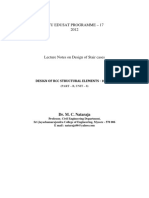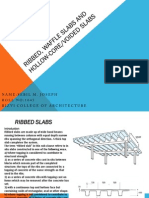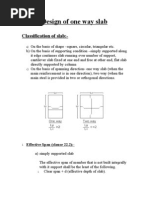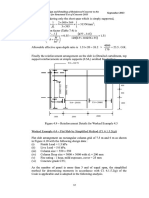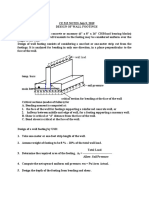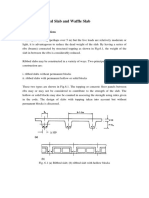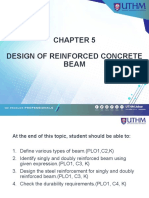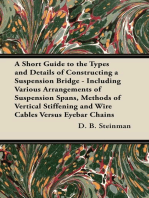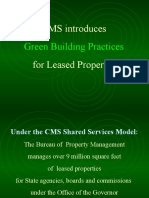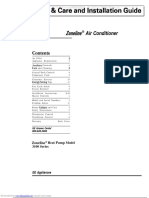Chapter 4 Ribbed Slabs and Waffle Slabs
Chapter 4 Ribbed Slabs and Waffle Slabs
Uploaded by
Sharan BvpCopyright:
Available Formats
Chapter 4 Ribbed Slabs and Waffle Slabs
Chapter 4 Ribbed Slabs and Waffle Slabs
Uploaded by
Sharan BvpCopyright
Available Formats
Share this document
Did you find this document useful?
Is this content inappropriate?
Copyright:
Available Formats
Chapter 4 Ribbed Slabs and Waffle Slabs
Chapter 4 Ribbed Slabs and Waffle Slabs
Uploaded by
Sharan BvpCopyright:
Available Formats
Chapter 4
Ribbed Slabs and Waffle Slabs
Ribbed slabs are used for long spans with relatively light loads. They are constructed in one of the following ways as described in clause 30 of IS: 456-2000 1. As a series of concrete ribs with topping. 2. As a series of concrete ribs or solid blocks, between precast hollow as a solid blocks. 3. With continuous top and bottom but containing voids of rectangular, oval or other shapes. These three types of constructions are shown in fig. 14.1.
(a) Series of concrete ribs with topping
(b) Concrete ribs or solid blocks, between precast hollow as a solid blocks
(c) Continuous top and bottom but containing voids Fig. 4.1 Ribbed slab construction
Design of Reinforced Concrete & Post-Tensioned flat slab using software 1
Chapter 4
Ribbed Slabs And Waffle Slabs
4.1 PROPORTIONING THE DIMENSIONS OF RIB
The ribs may have rectangular, trapezoidal or any other appropriate shape. If trapezoidal (or other shaped) rib is provided, the width of rib is calculated as an average width excluding topping. The minimum width of the rib shall be determined in accordance with minimum cover required to the reinforcement. The minimum width of the rib shall not be less than 65 mm. The depth of the rib excluding topping shall not be more than four times the width of rib. Maximum spacing of the ribs shall be 1.5 m.
4.2 ANALYSIS AND DESIGN PROCEDURE OF RIBBED SLAB
Ribbed slab can be idealized as a solid slab replaced by a series of beams which are spaced at smaller distances. Loading from the topping shall be transferred to the ribs simply by twoway reinforced jail, usually formed by minimum reinforcement. The ribs can be analyzed by the usual procedure applicable to the solid slabs. If the ribs are continuous, they can be analyzed by one of the following ways. (1) As continuous ribs, which may be analyzed by using coefficients applicable to continuous beams or slabs if it has three or more than three uniformly loaded and approximately equal spans; if not, these can be analyzed by moment distribution considering various live load arrangement. (2) If the ribs are not exposed to the weather or corrosive conditions, and if the support cracks can be permitted, then continuous ribs are designed as a series of simply supported ribs. In addition, few reinforcement at the support shall be provided to reduce the cracks at the support. The ribs are now designed as follows:
(a) Design for flexure The ribs are designed as tee or ell beams. The width of the flange is usually the actual width of the flange owing to the smaller spacing of the ribs. For example, a central tee beam has a
Design of Reinforced Concrete & Post-Tensioned flat slab using software. 2
Chapter 4
Ribbed Slabs And Waffle Slabs
flange width equal to the spacing of the ribs. For continuous ribs, support section is designed as a rectangular section.Moment reinforcement consists of one bar or more than one bar at the bottom or at the top as the case may be.If the continuous ribs are designed as simply supported ribs, support reinforcement equal to 25 per cent of span reinforcement shall be provided. These reinforcement shall extend at least one-tenth of clear span into adjoining spans.Clear cover to the main reinforcement shall be as per the solid slabs. However, If the ribbed slab Is provided with permanent hollow concrete blocks, the side cover may be 10 mm.The topping shall be usually provided with minimum reinforcement i.e. 0.12% with HYSD bars and 0.15% with mild steel bars. The spacing of topping reinforcement shall not be more than one-half the spacing of the ribs. If the ribs are widely spaced. the reinforcement shall be designed.
(b) Design for shear Ribs are designed for shear as follows: (1) If v < c/2, shear reinforcement Is not required. (2) If c > v > c/2, minimum shear reinforcement as per beam design should be provided, if the rib contains two or more bars. Top bars of diameter at least equal to the diameter of stirrups, two in number, should be used to hold the shear reinforcement. If the rib contains only one bar, shear reinforcement is not necessary. (3) If v > c, shear reinforcement shall be designed as per beam design for shear. (4) According to IS: 456, art. 30.3, where hollow blocks are used, for the purpose of calculating shear stress, the rib width may be increased to take account of the wall thickness of the block on one side of the rib; with narrow precast units, the width of the joining mortar or concrete may be included.
(c) Development length, deflection and cracking The rules to check development length, deflection and cracking shall be as per solid slab or flanged beam design as the case may be.
Design of Reinforced Concrete & Post-Tensioned flat slab using software. 3
Chapter 4
Ribbed Slabs And Waffle Slabs
4.3 WAFFLE SLABS
Fig. 4.2 Waffle slab
4.3.1 TWO-WAY SPANNING RIBBED SLABS: WAFFLE SLABS Ribbed slabs discussed in the previous articles are one-way spanning. We shall now discuss two-way spanning ribbed slabs. Such slabs are also termed as waffle slabs. The analysis and design set out for one-way spanning ribbed slabs in previous articles are applicable to waffle slabs also. The moments in the ribs may be determined by using the coefficients for two-way, solid slabs. Load transfer from waffle slabs to the supporting beams shall be assumed as per two-way solid slabs. Waffle slabs are usually made solid in some portion around the supporting beams - to resist negative bending moment - to resist torsion at the edges In the end spans
Design of Reinforced Concrete & Post-Tensioned flat slab using software. 4
Chapter 4
Ribbed Slabs And Waffle Slabs
- to provide flanges to the supporting beams and thus to Increase the moment carrying capacity of supporting beams. Introducing voids to the soffit reduces dead weight and these deeper, stiffer floors permit longer spans which are economic for spans between 9 and 14 m. The saving of materials tends to be offset by complication in site operations. Standard moulds are 225, 325 and 425 mm deep and are used to make ribs 125 mm wide on a 1000 mm grid. Toppings are between 50 and 150 mm thick. The chart and data assume surrounding and supporting downstand beams, which should be subject to separate consideration, and solid margins. Both waffles and downstand beams complicate formwork.
4.3.2 ADVANTAGES Medium to long spans Lightweight Profiles may be expressed architecturally, or used for heat transfer.
4.3.3 DISADVANTAGES Higher formwork costs than for other slab systems Slightly deeper members result in greater floor heights Construction work is slow, difficult to prefabricate reinforcement.
Design of Reinforced Concrete & Post-Tensioned flat slab using software. 5
Chapter 4
Ribbed Slabs And Waffle Slabs
4.3.4 SPAN: DEPTH CHART FOR WAFFLE SLAB
Fig. 4.3 Span: Depth chart
Design of Reinforced Concrete & Post-Tensioned flat slab using software. 6
Chapter 4
Ribbed Slabs And Waffle Slabs
4.4 SAMPLE CALCULATION OF DESIGN OF REINFORCED CONCRETE WAFFLE SLAB
Design of interior panel of a WAFFLE slab (Two-way slab) Size of slab :8 m x Concrete grade :M30 Steel grade :Fe415 Conseder live load :4 kN/m2 Solution : a) Proposed arrangement :total thickness of slab :Thichness of topping :8 m
Spacing of ribs :width of waffle :depth of waffle :slab is made solid for width at edges in all panels. b) Loading :Topping :self wt. 0.075 x 25 :1.875 kN/m2 floor finish :2 kN/m2 live load :4 kN/m2 Total :7.875 kN/m2 Rib :From topping :0.5 x 7.875 :3.9375 kN/m self wt. :0.225 x 25 :0.703125 kN/m 0.125 x Total :4.641 kN/m Factored load :1.5 x 4.641 :6.96 kN/m c) Shear and moments :shear at support (thickned slab) :- (w x l)/2 :27.84 kN shear 1000 at mm from supp. (ribs) :0.5 x :27.844 6.96 :24.36 kN For two-way slab :l/b :1.000
300 mm 75 mm 1000 mm 125 mm 225 mm 500 mm
(Two-way ribbed slab)
Design of Reinforced Concrete & Post-Tensioned flat slab using software. 7
Chapter 4
Ribbed Slabs And Waffle Slabs
x(+) :- y(+) :x(-) :- y(-) :Mu(+) :- x w Mu(-) :- y w d) Flexure reinforcement :Assume 12 mm diameter bars dx :dx :Positive moment reinforcement :section is designed as a tee beam bf :bw :(second layer is considered for symmetry)
2 lx 2 ly
0.024 0.032 ::10.69 14.26 269 mm 257 mm 1000 125 75 257 0.292 10.7 kNm mm mm mm mm kNm kNm
Df :d :Df / d :>
2
Mu(+) :-
11 kNm ,
2
bf / bw :-
8.00 0.845
Mu,lim. T / (fck bw d ) :Mu,lim. T :Ast :134.91 mm
2
(Table 58, SP : 16)
209.2928 kNm
(Mu / (0.87 fy d))
provide 2 10 # :- 157 mm Negative moment reinforcement :14.3 1000 Mu(-) :kNm b :mm 2 Mu/bd :0.20 pt provide
:-
d :-
269 mm
0.055 Ast 8 #
pt = 50
{ [1-(1-(4.6Mu/fckbd2))] / (fy/fck) }
2
3 -
:147.9833 mm between ribs + 2 :500 mm 251.2 mm
2
8 # (top bars of rib)
:150.72 + 100.48
e) Shear :Shear in ribs at Vu :-
from support d :- 257 mm Vu /(b d)
2
24.36 kN v :100 As/(b d) :-
b :- 125 mm 0.758 N/mm 0.49
Design of Reinforced Concrete & Post-Tensioned flat slab using software. 8
Chapter 4
Ribbed Slabs And Waffle Slabs
c :v vuc :- c b d :vus :- vu - vuc :use
0.5 N/mm > c
( Page :- 73, IS : 456,2000) Shear design necessary.
16.06 kN 8.301 kN 57 mm
2
6 mm
dia two-legged stirrups with Asv :sv :- (0.87 fy Asv d) / vus :380.6 mm spacing required for minimum shear reiforcement. sv :- (0.87 fy Asv) / 0.4b :245.9 mm
193 maximum spacing permitted, sv,max :- 0.75 d :mm 6 mm dia @ 193 mm two-legged stirrups throught. provide f) Development lenfth :177.2 Ld for negative moment bars mm :anchorage available 1000 mm .ok :for positive moment bars Mu1 :- 0.87 Fy Ast d 13.123 kN :Vu L0 ::0.7002 + 8# 24.3633 kN 8 #
> 22.0684 < # 8 # g) Check for moment design at junction of solid slab and ribbed slab ::negative moment reinforcement is designed considering the section 1000 mm
1.3 Mu1/vu + L0 > Ld
177 mm .ok x 300 mm .ok
from support Mu(-) 1 m :h) Deflection :basic span / d ratio
10.11
:-
kNm
<
Mu(-)
26 0.05 2.0 52 31 (page no. 38; IS 456-2000)
< 52
pt :- 100 As / (bf d)
modification factor permissible span / d actual span / d
::::-
.ok
Design of Reinforced Concrete & Post-Tensioned flat slab using software. 9
Chapter 4
Ribbed Slabs And Waffle Slabs
i) Topping reinforcement :As :mm /m. 90 d :56 assume Maximum spacing :- 5 d :# wrapping mesh @ 200 mm
2
6.00 280
c/c :-
dia bar. mm.
use
6 mm
2
141
mm /m at the centre of topping. steel quantity along long span (+ve)steel :L :No. of bars :weight of steel :along short span (+ve) steel :L :No. of bars :weight of steel :along long span (-ve)steel :L :No. of bars :weight of steel :along short span (-ve) steel :L :No. of bars :weight of steel :along long span (-ve)steel :L :No. of bars :weight of steel :along short span (-ve)steel :L :No. of bars :weight of steel :2 8 16 79 2 8 16 79 2 8 16 51 2 8 16 51 3 4 24 38 3 4 24 38 10 # m nos. kg. 10 # m nos. kg. 8 # m nos. kg. 8 # m nos. kg. 8 # m nos. kg. 8 # m nos. kg. (bottom steel of rib beam)
(bottom steel of rib beam)
(top steel of rib beam)
(top steel of rib beam)
(between ribs)
(between ribs)
topping reinforcement along long span steel :6 # L :1
200 m
mm c/c
Design of Reinforced Concrete & Post-Tensioned flat slab using software. 10
Chapter 4
Ribbed Slabs And Waffle Slabs
No. of bars weight of steel along short span steel :L No. of bars weight of steel
:::::-
384 85 6 1 384 85
nos. kg. 200 m nos. kg.
mm c/c
shear reinforcement : along long span steel :L :No. of bars :weight of steel :along short span steel :L :No. of bars :weight of steel :-
6 # 0.85 332 63 6 # 0.85 332 63
193 m nos. kg. 193 m nos. kg.
mm c/c
mm c/c
total steel required for 3 span. total steel required :Total cost of steel :quantity of conc.in topping slab :-
12915 419724.3
kg. Rs. 43.20 86.40 28.35 46.08 m m %
3
m m m m
3 3 3 3
quantity of solid slab near mainbeam :quantity of ribbed beams :quantity of main beams :total quantity of concrete :quantity of steel in m :% of steel :Total cost of slab :interior panel bottom fibre stress :-M y / I :3
204.03 1.65 0.81 1431773
Rs.
2
7.60E+00 N/mm
Design of Reinforced Concrete & Post-Tensioned flat slab using software. 11
You might also like
- Bank of ChinaDocument20 pagesBank of ChinaSharan Bvp100% (3)
- One Way Ribbed SlabDocument4 pagesOne Way Ribbed Slabwissam nadir100% (2)
- Ribbed Slab DesignDocument19 pagesRibbed Slab DesignMohammad Ali96% (50)
- One-Way Ribbed Slab Design As Per BS8110Document5 pagesOne-Way Ribbed Slab Design As Per BS8110yusuf abdinasir100% (5)
- Hollow Block SlabsDocument9 pagesHollow Block Slabsardabili0% (1)
- Hollow Pot DesignDocument4 pagesHollow Pot Designgaza man100% (2)
- Column SplicingDocument31 pagesColumn Splicingprabhu8160% (5)
- Ribbed SlabsDocument10 pagesRibbed SlabsAlemayehu DargeNo ratings yet
- Waffle SlabsDocument14 pagesWaffle SlabsRaju Shrestha50% (2)
- Inclined Columns Design - Loads and Bending Moment in Inclined ColumnDocument5 pagesInclined Columns Design - Loads and Bending Moment in Inclined ColumnJustin Musopole100% (2)
- Reinforced Concrete Buildings: Behavior and DesignFrom EverandReinforced Concrete Buildings: Behavior and DesignRating: 5 out of 5 stars5/5 (1)
- 05 Matrix TrussDocument83 pages05 Matrix TrussSharan BvpNo ratings yet
- CONCRETE STRUCTURES - Final Exam PDFDocument2 pagesCONCRETE STRUCTURES - Final Exam PDFaroNo ratings yet
- Ashrae 110: An Introduction To Laboratory Fume Hood Performance TestingDocument19 pagesAshrae 110: An Introduction To Laboratory Fume Hood Performance Testingryu181189No ratings yet
- ABTCO Vinyl General Installation InstructionsDocument44 pagesABTCO Vinyl General Installation InstructionsVon LopezNo ratings yet
- Ribbed and Waffle SlabsDocument5 pagesRibbed and Waffle SlabsRenzon Sison100% (1)
- Ribbed Slab DesignDocument11 pagesRibbed Slab DesignJavier_GL100% (3)
- PORTAL FRAME (Fixed Base)Document14 pagesPORTAL FRAME (Fixed Base)Viji NpNo ratings yet
- Unit8 PDFDocument14 pagesUnit8 PDFVictor OmotoriogunNo ratings yet
- Lect2 - 1 11 2011 PDFDocument62 pagesLect2 - 1 11 2011 PDFgendadeyu552625100% (1)
- Cantilever Slab DesignDocument18 pagesCantilever Slab DesignSarah Huff67% (9)
- Analysis and Design of Cantilever SlabDocument9 pagesAnalysis and Design of Cantilever SlabJaime Manalili Landingin100% (1)
- Voided and Ribbed SlabsDocument17 pagesVoided and Ribbed SlabsNayeeSoch100% (2)
- Proportionate and Nonproportionate Shear WallsDocument5 pagesProportionate and Nonproportionate Shear WallsHumberto Estevez100% (1)
- Chapter 2. Analysis and Design of One-Way Ribbed Slabs: Figure 2-1 - Ribbed Slab LayoutDocument3 pagesChapter 2. Analysis and Design of One-Way Ribbed Slabs: Figure 2-1 - Ribbed Slab LayoutTesfa HunderaNo ratings yet
- Design of Timber Roof Truss To British Code - Solved Example - StructvilleDocument9 pagesDesign of Timber Roof Truss To British Code - Solved Example - StructvilleDeRudy100% (3)
- Analysis and Design of Ribbed SlabDocument7 pagesAnalysis and Design of Ribbed Slabtesh75% (4)
- One Way Solid Slab DesignDocument26 pagesOne Way Solid Slab DesignJohn Mejia50% (4)
- Inclined ColumnDocument6 pagesInclined ColumnRabindraUpreti0% (1)
- Strap FoundationDocument6 pagesStrap FoundationDarryl Arpilleda100% (1)
- Design of 2 Way SlabsDocument15 pagesDesign of 2 Way Slabsdeepak mangesh80% (15)
- Design of One Way SlabDocument31 pagesDesign of One Way SlabRam Ingalkar90% (10)
- Flat SlabDocument93 pagesFlat SlabTan100% (1)
- Design of Wall FootingDocument6 pagesDesign of Wall FootingEvhander Saligumba MoscaNo ratings yet
- Design Example of Flat Slab by Equilavent Frame MethodDocument16 pagesDesign Example of Flat Slab by Equilavent Frame MethodWendimu Tolessa100% (2)
- Flat Slab BhavikattiDocument23 pagesFlat Slab BhavikattiSharath GuptaNo ratings yet
- Flat Slab-PPt-By Habtamu T.Document39 pagesFlat Slab-PPt-By Habtamu T.paulos dagnaw67% (3)
- Resistance Moment Calculations (Columns BS 8110)Document3 pagesResistance Moment Calculations (Columns BS 8110)dhanya1995100% (3)
- Analysis and Design of Shear WallsDocument24 pagesAnalysis and Design of Shear WallsRkkodi100% (4)
- Analysis and Design of Shear WallDocument30 pagesAnalysis and Design of Shear WallAnonymous 5VwQ0KC380% (10)
- CSE 313 Lecture 4 - ExamplesDocument22 pagesCSE 313 Lecture 4 - ExamplesKelvho Gitonga75% (4)
- Combined Footing DesignDocument10 pagesCombined Footing Designmido medo100% (1)
- Design of StaircaseDocument16 pagesDesign of StaircaseOscarKonzultNo ratings yet
- Steel Roof TrussesDocument46 pagesSteel Roof TrussesMohd Hafizi Bin AzlanNo ratings yet
- Chapter 4 Ribbed Slabs and Waffle SlabsDocument11 pagesChapter 4 Ribbed Slabs and Waffle SlabsAssefa Nigussie100% (1)
- Chapter 6 Ribbed Slab and Waffle SlabDocument15 pagesChapter 6 Ribbed Slab and Waffle Slaba20082909No ratings yet
- Lecture 9Document34 pagesLecture 9mayaraedh.eNo ratings yet
- 4.0 Slab Introduction & Design of One-way Slab-1Document24 pages4.0 Slab Introduction & Design of One-way Slab-19r4rr962ynNo ratings yet
- CIV5304: Design of Structural Elements III: Engr DR Nuruddeen Muhammad MusaDocument30 pagesCIV5304: Design of Structural Elements III: Engr DR Nuruddeen Muhammad MusaNuruddeen MuhammadNo ratings yet
- One Way Slab DesignDocument19 pagesOne Way Slab DesignMandar NadgaundiNo ratings yet
- 如何撰写英语科技论文 (1) - 潘 晨 - 000294Document59 pages如何撰写英语科技论文 (1) - 潘 晨 - 000294malachi.chikodzoNo ratings yet
- Design of SlabsDocument17 pagesDesign of SlabsAmay mishraNo ratings yet
- ACI 318 14 Changes PCI JournalDocument11 pagesACI 318 14 Changes PCI Journalhakim2020No ratings yet
- Slabs FinalDocument30 pagesSlabs FinalMwa100% (3)
- RCI Hand Out Chapter 4 - PPT - 4.2 One Way Ribbed SlabDocument46 pagesRCI Hand Out Chapter 4 - PPT - 4.2 One Way Ribbed SlabNathnael Jia100% (3)
- 5 - Design of Reinforced Concrete BeamDocument25 pages5 - Design of Reinforced Concrete BeamyakaNo ratings yet
- How To Design A Two-Way SlabDocument90 pagesHow To Design A Two-Way Slabshak543No ratings yet
- CIV5304: Design of Structural Elements III: Engr DR Nuruddeen Muhammad MusaDocument22 pagesCIV5304: Design of Structural Elements III: Engr DR Nuruddeen Muhammad MusaNuruddeen Muhammad100% (1)
- Reinforced Concrete Slab Bridge With Hollow Concrete BlockDocument12 pagesReinforced Concrete Slab Bridge With Hollow Concrete BlockEpct ArchiveNo ratings yet
- UNIT-3 NotesDocument23 pagesUNIT-3 NotesKrishnakanth ChidreNo ratings yet
- Paper Reinforced Concrete SlabsDocument32 pagesPaper Reinforced Concrete SlabsTHRESNANo ratings yet
- Lecture5 ADocument36 pagesLecture5 ALowie Torres TonioNo ratings yet
- Reinforced Concrete Slab DesignDocument70 pagesReinforced Concrete Slab DesignLeandro Madeira100% (1)
- CH4 (1) MergedDocument231 pagesCH4 (1) Mergedأزهار برديNo ratings yet
- A Short Guide to the Types and Details of Constructing a Suspension Bridge - Including Various Arrangements of Suspension Spans, Methods of Vertical Stiffening and Wire Cables Versus Eyebar ChainsFrom EverandA Short Guide to the Types and Details of Constructing a Suspension Bridge - Including Various Arrangements of Suspension Spans, Methods of Vertical Stiffening and Wire Cables Versus Eyebar ChainsNo ratings yet
- Chapter 5 Post-Tensioned SlabDocument19 pagesChapter 5 Post-Tensioned SlabSharan BvpNo ratings yet
- W.h.mosley - J.h.bungey. Reinforced Concrete DesignDocument199 pagesW.h.mosley - J.h.bungey. Reinforced Concrete DesignSharan BvpNo ratings yet
- Prestressed Concrete RC SlabsDocument3 pagesPrestressed Concrete RC SlabsSharan BvpNo ratings yet
- Chapter 2 Literature ReviewDocument10 pagesChapter 2 Literature ReviewSharan BvpNo ratings yet
- AbstractDocument2 pagesAbstractSharan BvpNo ratings yet
- CMS Introduces: Green Building PracticesDocument23 pagesCMS Introduces: Green Building PracticesSharan BvpNo ratings yet
- Polysafe Wood FX AcoustixDocument1 pagePolysafe Wood FX AcoustixFloorkitNo ratings yet
- SR - No Item Unit Requirement in Bags RemarksDocument5 pagesSR - No Item Unit Requirement in Bags RemarksRavi kumarNo ratings yet
- 4F Design-2Document12 pages4F Design-2Jake CortezNo ratings yet
- Bahan AcDocument3 pagesBahan AcAnnisa Yasmin Noor ZainNo ratings yet
- 2020 EDITION DMCC Retail Design GuidelinesDocument38 pages2020 EDITION DMCC Retail Design Guidelinesthảo huỳnh100% (3)
- Case Study of STATE SECRETARIATNDocument19 pagesCase Study of STATE SECRETARIATNchiomaNo ratings yet
- Wind Load Calculation + Design CriteriaDocument7 pagesWind Load Calculation + Design CriteriaAnonymous 2Dz4Kq9M7No ratings yet
- Mitsubishi Electric City Multi YKB YLM Catalogue EngDocument78 pagesMitsubishi Electric City Multi YKB YLM Catalogue EngΠΟΤΕΤΣΙΑΝΑΚΗ ΑΣΗΜΟΜΥΤΗΣNo ratings yet
- Sr. No. - 01.1 Ward No. - 05 Construction of C.C Road in Anna Patil Near Public ToiletDocument11 pagesSr. No. - 01.1 Ward No. - 05 Construction of C.C Road in Anna Patil Near Public Toiletnajuka ghodvindeNo ratings yet
- ABC PBR-PBU Manual PDFDocument31 pagesABC PBR-PBU Manual PDFRandy MillerNo ratings yet
- CLIMACENTA Product OverviewDocument8 pagesCLIMACENTA Product OverviewJeremy DiazNo ratings yet
- Glass-Fused-to-Steel Tanks - Bolted Glass Fused To Steel Tanks - Epoxy Coated Steel Tanks - Stainless Steel Tanks - YHR TanksDocument5 pagesGlass-Fused-to-Steel Tanks - Bolted Glass Fused To Steel Tanks - Epoxy Coated Steel Tanks - Stainless Steel Tanks - YHR TanksJuan SedanoNo ratings yet
- Under Reamed Pile-5108Document12 pagesUnder Reamed Pile-5108anku510883% (6)
- Method Staitement-For Construcion of Sump For Drinking Water, Cultivation Water& Storm Water (Comment)Document3 pagesMethod Staitement-For Construcion of Sump For Drinking Water, Cultivation Water& Storm Water (Comment)indikuma50% (2)
- 19021D2021 Mini ProjectDocument27 pages19021D2021 Mini ProjectAravindNo ratings yet
- C500 450 OPC 25 MS Screed WP ES 7 Days - Option 4 Roof ShellDocument1 pageC500 450 OPC 25 MS Screed WP ES 7 Days - Option 4 Roof ShellEslam SamyNo ratings yet
- Modern Methods of ConstructionDocument5 pagesModern Methods of ConstructionDavid ShutteNo ratings yet
- Loadbearing Architectural Precast Concrete Wall PanelsDocument24 pagesLoadbearing Architectural Precast Concrete Wall PanelsLuis Pablo Ramirez ZavalaNo ratings yet
- Design Manuscript For Ce StudentsDocument167 pagesDesign Manuscript For Ce StudentsJehana NaolNo ratings yet
- Omega Lighting WY4000LHTW INC A-Lamp Wallwash Downlight Spec Sheet 1-86Document2 pagesOmega Lighting WY4000LHTW INC A-Lamp Wallwash Downlight Spec Sheet 1-86Alan MastersNo ratings yet
- Span CastDocument20 pagesSpan CastAddrien DanielNo ratings yet
- Zoneline 3100 SeriesDocument16 pagesZoneline 3100 SeriespotoculNo ratings yet
- Say NO To PVC Concrete Spacers PDFDocument1 pageSay NO To PVC Concrete Spacers PDFSOURAV RANJAN KHANRANo ratings yet
- Tempstar N9MP1 InstallDocument70 pagesTempstar N9MP1 InstallTokyNo ratings yet
- Catalogue 2017 PDFDocument66 pagesCatalogue 2017 PDFCarlos Castro Alvarez100% (1)
- Industrial Training Report: Sarhad University of Science and Information Technology PeshawarDocument11 pagesIndustrial Training Report: Sarhad University of Science and Information Technology Peshawaramjad aliNo ratings yet
- Heat Exchanger Refrigeration & Air Conditioning Outline of PresentationDocument29 pagesHeat Exchanger Refrigeration & Air Conditioning Outline of Presentationsantosh kumarNo ratings yet


















